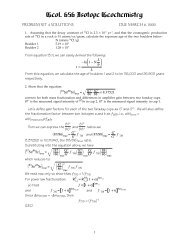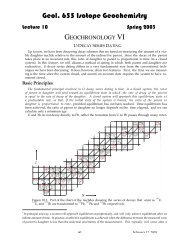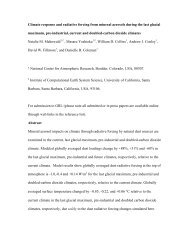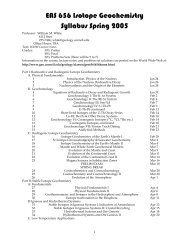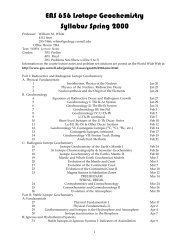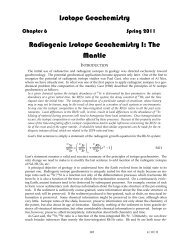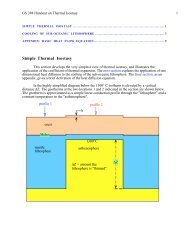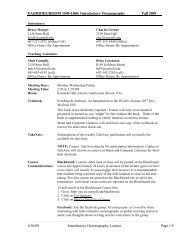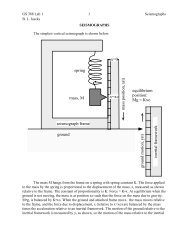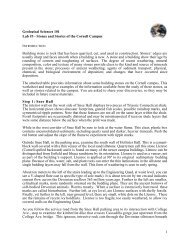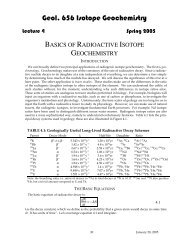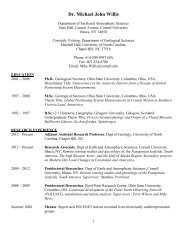Lab Handout
Lab Handout
Lab Handout
Create successful ePaper yourself
Turn your PDF publications into a flip-book with our unique Google optimized e-Paper software.
of commonly-occurring rocks to the Ithaca area. Rock Group 1 will represent average Earth<br />
crust. Rock Group 2 (peridotite) will represent the interior – the mantle of the Earth. Rock<br />
Group 3 is just for fun. These are samples of volcanic pumice, and are formed when dissolved<br />
gasses come out of the magma solution when volcanoes erupt.<br />
• Select a group of samples from each of the 3 boxes provided.<br />
• Use the small lab scale to measure the mass of the group (put them all in the tray together);<br />
try to find a group of samples with a cumulative mass of 200-400 grams<br />
• Find the volume of each sample by immersing the samples in water using a large graduated<br />
cylinder. 1 ml = 1 cm 3 .<br />
• Find the total volume of the sample group that you weighed.<br />
• Calculate the density in units of g/cm 3 .<br />
(2) What density did you calculate for (a) Rock Group 1 (b) Rock Group 2 (c) Rock Group 3<br />
Show your work.<br />
PART III - VISCOSITY<br />
Viscosity (η) is defined as the resistance of a fluid to flow. Fluids with low viscosities flow very<br />
easily, fluids with high viscosities flow only very slowly. We can measure viscosity by<br />
measuring the speed at which objects fall through fluids. You will test the viscosity of water,<br />
mineral oil, honey and glycerin by dropping small steel weights into these fluids and timing their<br />
descent. Viscosity is measured in units of force and time (force x time, which is called a Pascalsecond,<br />
or Pa•s).<br />
Fill the largest graduated cylinder (1000 ml) with water, nearly to the top (you don't need to<br />
know the volume this time). Get your stopwatch ready. Carefully drop a steel bead into the<br />
cylinder so that it does not hit the sides (although you may find this difficult…). Time the<br />
descent of the bead as best you can. Velocity is measured in units of m/s (meters per second).<br />
Measure the distance that you allowed the bead to fall (you can measure in cm and then convert<br />
to m: 1 m = 100 cm). Repeat this measurement three or more times and average your results.<br />
(3) Calculate the velocity of the bead in water.<br />
The viscosity of water is .001 Pa•s (η = .001 Pa•s =.001 kg/m·s). We can compare the viscosity<br />
of other fluids to water by comparing the velocities of beads as they fall through these other<br />
fluids. The difference in velocity (V) is inversely proportional to the difference in viscosity:<br />
Vwater =<br />
Voil<br />
ηoil<br />
ηwater<br />
(4) Find the velocity of beads in mineral oil, honey and glycerin (use the medium-sized<br />
graduated cylinders for oil (250 or 500 ml) & glycerin (100 ml), the smallest for honey (25 ml)).<br />
2



